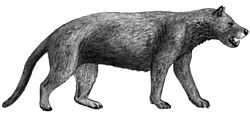Ysengrinia
From Wikipedia, the free encyclopedia
| Ysengrinia Temporal range: Late Oligocene–Early Miocene | |
|---|---|
 | |
| Restoration | |
| Scientific classification | |
| Kingdom: | Animalia |
| Phylum: | Chordata |
| Class: | Mammalia |
| Order: | Carnivora |
| Suborder: | Caniformia |
| Family: | Amphicyonidae |
| Subfamily: | Amphicyoninae |
| Genus: | †Ysengrinia Leidy (1853) |
Ysengrinia is an extinct genus of large, mostly carnivorous bone-crushing mammals known as bear dogs, of the family Amphicyonidae found in Europe during the Late Oligocene and Early Miocene, in North America during the Early Miocene, and possibly in southwestern Africa during the Early Miocene.[1][2]
Taxonomy
Ysengrinia was named by Leidy (1853). was named by Ginsburg (1965). It was assigned to Amphicyoninae by Hunt (1998); and to Amphicyonidae by Ginsburg (1965), Carroll (1988) and Hunt (2002).[3]
Morphology
A single specimen was examined by Legendre and Roth for body mass and was estimated to weigh 71.6 kg (160 lb).[4]
References
- ↑ McKenna, M.C.; Bell, S.K. (1997). Classification of Mammals: Above the Species Level. New York: Columbia University Press. p. 631. ISBN 978-0-231-11013-6.
- ↑ Hunt, R.M. (2002). "Intercontinental migration of Neogene Amphicyonids (Mammalia, Carnivora): Appearance of the Eurasian beardog Ysengrinia in North America". American Museum Novitates 3384 (1): 1–53. doi:10.1206/0003-0082(2002)384.3C0001:IMONAM>2.0.CO;2. hdl:2246/2873.
- ↑ R. M. Hunt. 2002. New amphicyonid carnivorans (Mammalia, Daphoeninae) from the early Miocene of southeastern Wyoming. American Museum Novitates 3385:1-41
- ↑ S. Legendre and C. Roth. 1988. Correlation of carnassial tooth size and body weight in recent carnivores (Mammalia). Historical Biology 1(1):85-98
This article is issued from Wikipedia. The text is available under the Creative Commons Attribution/Share Alike; additional terms may apply for the media files.